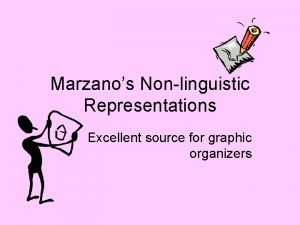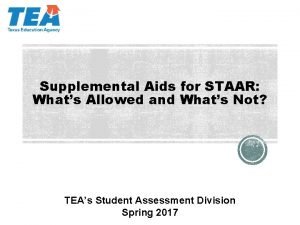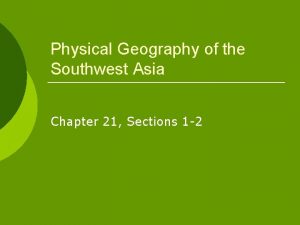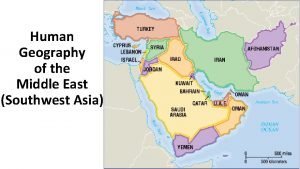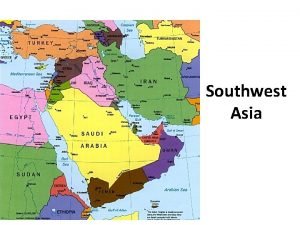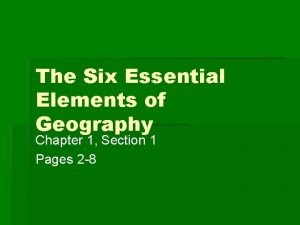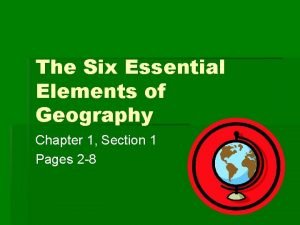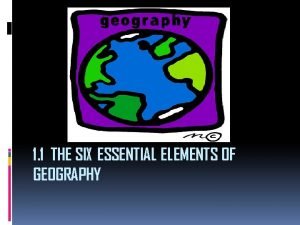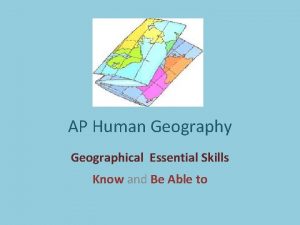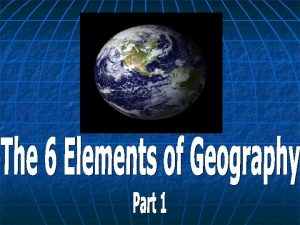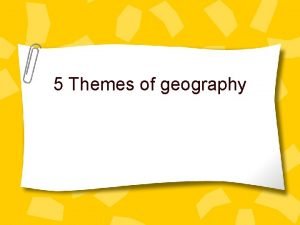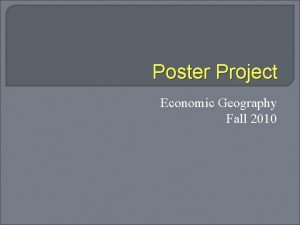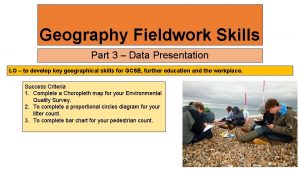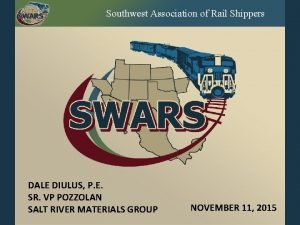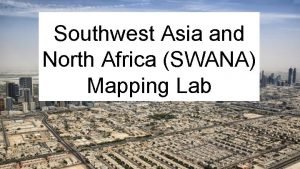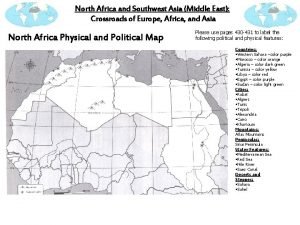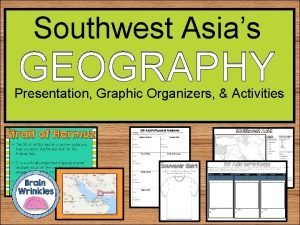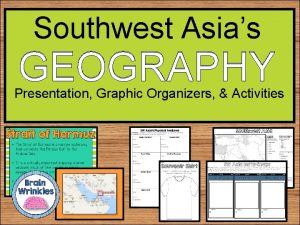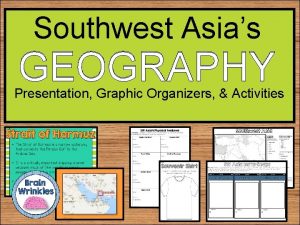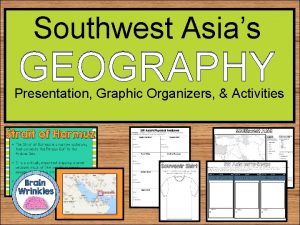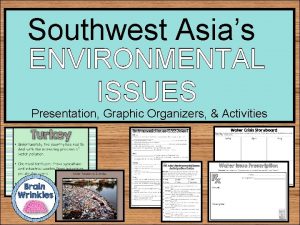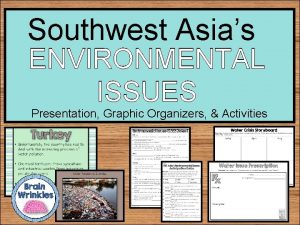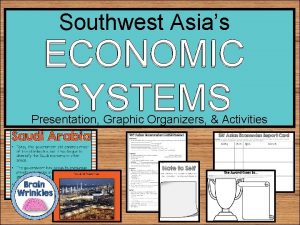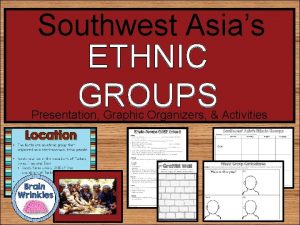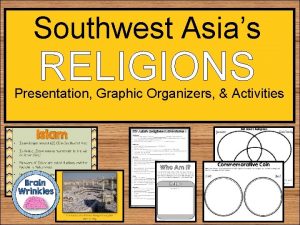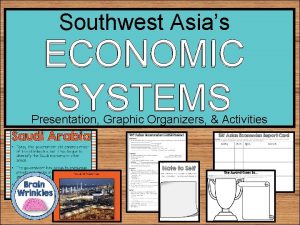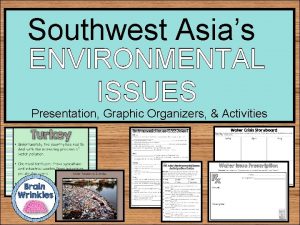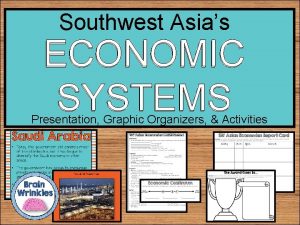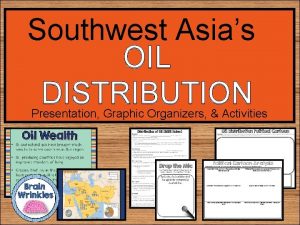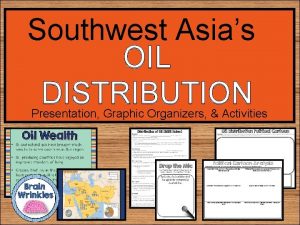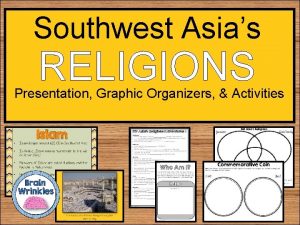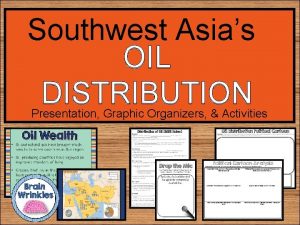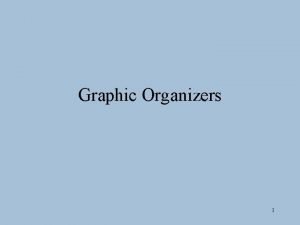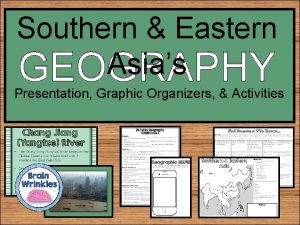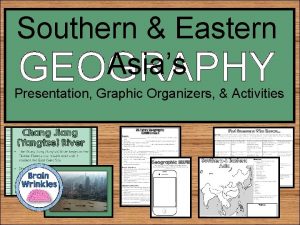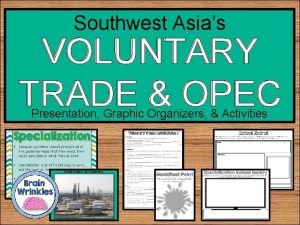Southwest Asias GEOGRAPHY Presentation Graphic Organizers Activities Essential























































- Slides: 55

Southwest Asia’s GEOGRAPHY Presentation, Graphic Organizers, & Activities

Essential Question: • How do important waterways affect life in the middle east? (use two examples in your response)

STANDARDS: SS 7 G 5 The student will locate selected features in Southwestern Asia (Middle East). a. Locate on a world and regional politicalphysical map: Euphrates River, Jordan River, Tigris River, Suez Canal, Persian Gulf, Strait of Hormuz, Arabian Sea, Red Sea, and Gaza Strip. b. Locate on a world and regional politicalphysical map the nations of Afghanistan, Iraq, Israel, Saudi Arabia, and Turkey. © Brain Wrinkles

Southwest Asia I. Political Features: Label the following countries on the map: • Afghanistan • Iraq • Israel • Saudi Arabia • Turkey Label the following physical features: • Euphrates River • Jordan River • Tigris River • Suez Canal • Persian Gulf • Strait of Hormuz • Arabian Sea • Red Sea • Gaza Strip © Brain Wrinkles

Southwest Asia KEY I. Political Features: Label the following countries on the map: Turkey Tigris River Afghanistan Euphrates River Iraq Gaza Israel Suez Strip Canal Iran • Afghanistan • Iraq • Israel • Saudi Arabia • Turkey II. Physical Features: Create a map key that includes symbols for: • Rivers • Seas • Canal • Gulf • Strait • Gaza Strip Label the following physical features: Jordan River • Euphrates River Persian Gulf Strait of Hormuz • Jordan River • Tigris River • Suez Canal Saudi Arabia Map Key • Persian Gulf • Strait of Hormuz • Arabian Sea • Red Sea • Gaza Strip Red Sea Arabian Sea © Brain Wrinkles Draw the symbol for each feature next to the correct label on the map. Color all symbols!

SW Asia’s Physical Features What: Red Sea Arabian Sea Strait of Hormuz Persian Gulf Directions: Complete the chart below with information that you learn during the presentation. If time allows, color your illustrations. What: Where: Euphrates River Where: Illustration: What: Where: Tigris River Where: Illustration: What: Where: Jordan River Where: What: Illustration: What: Where: Illustration: Suez Canal Illustration: © Brain Wrinkles

SW Asia’s Physical Features Gaza Strip Directions: Complete the chart below with information that you learn during the presentation. If time allows, color your illustrations. What: Where: Illustration: © Brain Wrinkles Create a slogan for your feature!

Southwest Asia’s Geography © Brain Wrinkles

Middle East • The Middle East is also known as the “crossroads of the world” because of its location in the center of three continents – Asia, Africa, and Europe. • Deserts are the most common physical feature here and make up 66% of the area. • Water is scarce in the region, with countries often competing over access to the rivers and seas. © Brain Wrinkles

© Brain Wrinkles

Euphrates River • The Euphrates and Tigris Rivers both start in the mountains of Turkey and run parallel to each other in some places. • In southern Iraq, the Euphrates River joins with the Tigris River to form one waterway called the Shaat al-Arab. • It then flows along the border between Kuwait and Iran and empties into the Persian Gulf. © Brain Wrinkles

© Brain Wrinkles

Euphrates River • The Euphrates is the birthplace of the ancient civilizations of Sumer, Babylon, & Assyria. • It is a source of water for Iraq, Syria, and Turkey today. © Brain Wrinkles

© Brain Wrinkles

Tigris River • Along with the Euphrates, the Tigris was part of ancient Middle Eastern civilizations. • The rivers provide water for both drinking and farming. • The Tigris River flows through Turkey to Iraq. • The countries that share these rivers have had problems over how the water should be shared. © Brain Wrinkles

© Brain Wrinkles

Jordan River • The Jordan River starts in the mountains of Israel, Lebanon, and Syria, and flows south until it reaches the Dead Sea. • It is only 20 feet wide at some parts and only 17 feet deep at its deepest point. • This river is a main source of water for Israel, Lebanon, Jordan, parts of Syria, & many of those living in the West Bank & the Gaza Strip. • The Jordan River is also important because it is the political boundary between Israel, the West Bank, & Jordan. © Brain Wrinkles

© Brain Wrinkles

© Brain Wrinkles

© Brain Wrinkles

Suez Canal • The Suez Canal connects the Red Sea to the Mediterranean Sea. • It is a 120 -mile man-made waterway that is used to transport goods to and from Asia, Africa, & Europe. • The Suez Canal is important shortcut because it allows trade between all three continents. • At the northern end of the Red Sea, ships can enter the canal and can get to the Mediterranean Sea without having to sail all around the continent of Africa. © Brain Wrinkles

© Brain Wrinkles

© Brain Wrinkles

© Brain Wrinkles

Persian Gulf • The Persian Gulf is a shallow body of water between Iran and the Arabian Peninsula. • This area holds some of the most important oil fields in the world. • It is one of the main ways oil is shipped from the rich fields of Kuwait, Saudi Arabia, Iran, and other countries that line its shores. • All of the countries that produce oil in that region depend on the Persian Gulf as a shipping route. © Brain Wrinkles

© Brain Wrinkles

© Brain Wrinkles

© Brain Wrinkles

© Brain Wrinkles

Strait of Hormuz • The Strait of Hormuz is a narrow waterway that connects the Persian Gulf to the Arabian Sea. • It is a critically important shipping channel because much of the world’s oil supply passes through this strait. • Any ships coming out of or into the Persian Gulf must navigate through this very narrow waterway. © Brain Wrinkles

© Brain Wrinkles

© Brain Wrinkles

© Brain Wrinkles

Arabian Sea • The Arabian Sea is located north of the Indian Ocean and is bordered by India to the east, Pakistan and Iran to the north, and the Arabian Peninsula to the west. • For centuries, it has formed a key shipping route between Europe and India through the Suez Canal. © Brain Wrinkles

© Brain Wrinkles

© Brain Wrinkles

Red Sea • The Red Sea is an arm of the Indian Ocean that lies between northeast Africa and Asia. • It is linked to the Mediterranean Sea by the Suez Canal. • Because of the Red Sea’s location between Europe and East Asia, heavy shipping traffic takes place here. • During the Middle Ages, it was a key part of the Spice Trade. © Brain Wrinkles

© Brain Wrinkles

© Brain Wrinkles

© Brain Wrinkles

© Brain Wrinkles

Gaza Strip • The Gaza Strip is located along the southeastern shore of the Mediterranean Sea, and is bordered on the south by Egypt, and on the north and east by Israel. • The Gaza Strip is a rectangular territory that is about 25 miles long and 4 to 5 miles wide. • It’s one of the world’s most densely populated areas. © Brain Wrinkles

© Brain Wrinkles

© Brain Wrinkles

Gaza Strip • The Gaza Strip is often politically unstable and there have been many outbreaks of violence over the last 60 years. • Disputes over this territory continue between Israel and surrounding countries. © Brain Wrinkles

© Brain Wrinkles

Stop Note taking here and answer the EQ…

TEACHER INFO: Flyswatter Review • Project a blank map of Southwest Asia on the whiteboard. • Put the students into groups and have one member from each group come to the board. • Call out different places/features in Southwest Asia and have the students use flyswatters to hit the location. • The first person to hit it correctly wins! © Brain Wrinkles

FLYSWATTER REVIEW • One member from each team will come to the board. • I will call out different political and physical features of Southwest Asia. • If you know where the feature or country is located, you should hit the location on the map. • The first person to correctly hit the location wins a point! © Brain Wrinkles

© Brain Wrinkles

Be the Thing… Your Task: • Choose ONE of SW Asia’s physical features and we’ll try to guess what you are! • Imagine that you are one of the physical features of SW Asia. Using descriptive details, include at least 5 interesting facts about yourself. • Draw a colorful illustration of the feature underneath your description. © Brain Wrinkles

Example: Can you believe it? I didn’t even exist less than two hundred years ago. Everyone says that I’m super important to the economy and blah, but I am so tired of everybody always using me. Chug, chug across me all day long. I miss the good ol’ days when I could relax and look out over the oil fields. All I see now are people in such a hurry to reach the other side. © Brain Wrinkles

Suez Canal © Brain Wrinkles

TEACHER INFO: Insta-Snaps • Print off the following slide & make a copy for each student. • The students will draw 3 pictures of places that they would like to visit in SW Asia (based on what they learned in the lesson). They should include a #summary for each picture. © Brain Wrinkles

Southwest Asia Comprehension Check 1. Which physical features make trade easier? 2. Much of the world’s oil supply is shipped through which waterway? 3. What is the body of water between northeast Africa and Asia called? 4. Which river is the key water source for Israel, Lebanon, and Syria? 5. Are there any physical features countries might fight over? Why do you think they would do this? 6. Which small territory has been a source of dispute between Israel and neighboring countries for years? 7. Which features holds massive reserves of oil? 8. What is the man-made structure that connects the Red Sea to the Mediterranean Sea called? 9. Which two rivers were the birthplace for ancient Middle Eastern civilization? © Brain Wrinkles
 Yellow sea and east china sea
Yellow sea and east china sea Tea supplemental aids
Tea supplemental aids Tea approved graphic organizers
Tea approved graphic organizers Tea approved supplemental aids
Tea approved supplemental aids Hierarchical topical organizer
Hierarchical topical organizer Universal accommodations for mcas
Universal accommodations for mcas Time sequence pattern organizer
Time sequence pattern organizer Grammar and mechanics rules for staar 2021
Grammar and mechanics rules for staar 2021 Marzano graphic organizers
Marzano graphic organizers Mcas accommodations
Mcas accommodations Chapter 22 human geography of southwest asia
Chapter 22 human geography of southwest asia North africa and southwest asia physical geography
North africa and southwest asia physical geography Map of southwest asia
Map of southwest asia Human geography of middle east
Human geography of middle east Chapter 21 physical geography of southwest asia
Chapter 21 physical geography of southwest asia Essential non essential fatty acids
Essential non essential fatty acids Splash graphic novel definition
Splash graphic novel definition Ghost graphic story graphic and wayfinding
Ghost graphic story graphic and wayfinding Cues questions and advance organizers
Cues questions and advance organizers Advance organizer model
Advance organizer model Expository advance organizers examples
Expository advance organizers examples Dear organizers
Dear organizers Discourse organizing words
Discourse organizing words Marzanos 9
Marzanos 9 Cues questions and advance organizers
Cues questions and advance organizers Skimming advance organizer examples
Skimming advance organizer examples Identify two essential elements of geography
Identify two essential elements of geography The six essential elements of geography
The six essential elements of geography The 6 essential elements of geography
The 6 essential elements of geography Geographical data ap human geography definition
Geographical data ap human geography definition Mrdowling
Mrdowling Six essential elements of geography definitions
Six essential elements of geography definitions The statement of cash flows helps users
The statement of cash flows helps users Which of these sports are indoor outdoor
Which of these sports are indoor outdoor Primary and support activities
Primary and support activities Primary activities and tertiary activities
Primary activities and tertiary activities 5 themes of geography graphic organizer
5 themes of geography graphic organizer Types of tertiary activities
Types of tertiary activities Leisure time presentation
Leisure time presentation Ap human geography frq examples
Ap human geography frq examples 5 themes of geography ap human geography
5 themes of geography ap human geography Stateless nation
Stateless nation Geography poster project
Geography poster project Complex data presentation geography
Complex data presentation geography Fetal lie
Fetal lie Fundal height transverse lie
Fundal height transverse lie Southwest airlines flight 1248
Southwest airlines flight 1248 The southwest states and capitals
The southwest states and capitals Northern virginia ems council
Northern virginia ems council Southwest association of rail shippers
Southwest association of rail shippers Brain wrinkles southwest asia
Brain wrinkles southwest asia Landforms of southwest asia
Landforms of southwest asia Southwest and central asia mapping lab answer key
Southwest and central asia mapping lab answer key Political map of north africa and southwest asia
Political map of north africa and southwest asia Political map of north africa and southwest asia
Political map of north africa and southwest asia Southwest airlines
Southwest airlines






